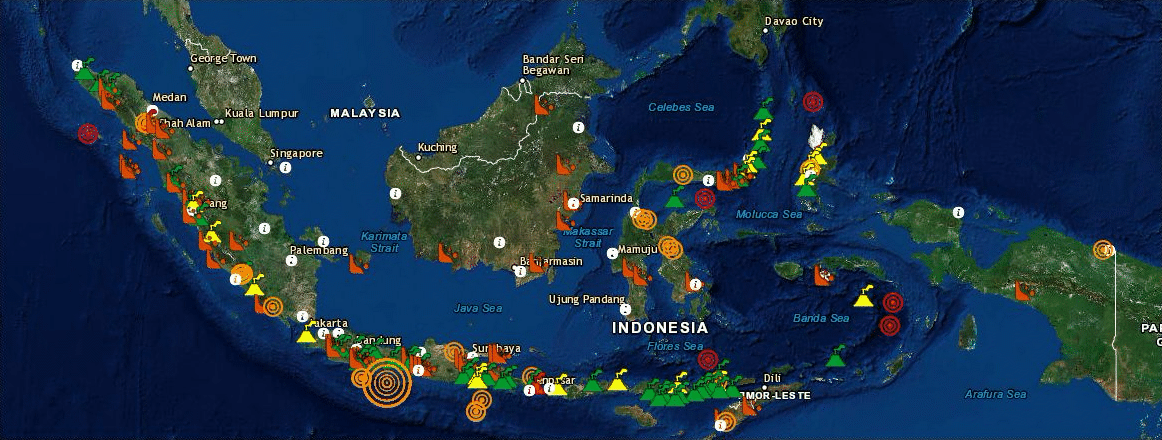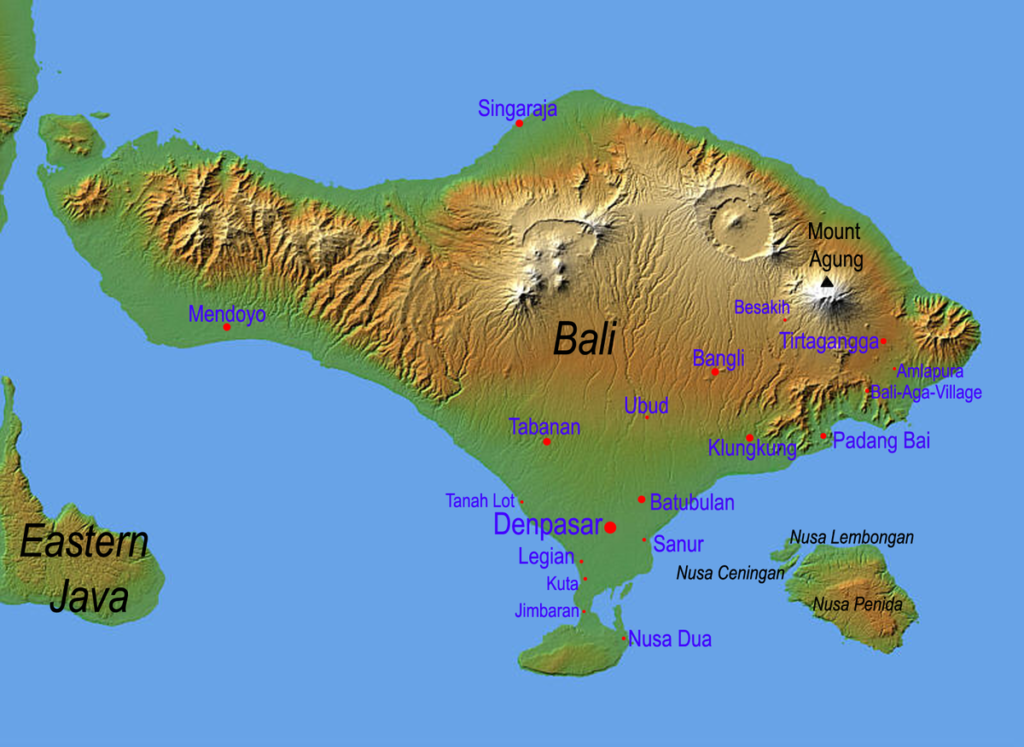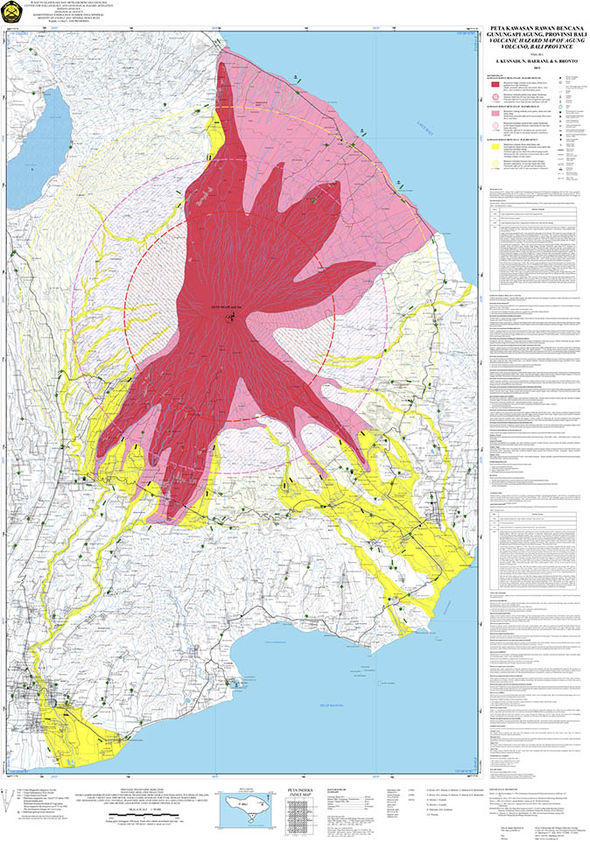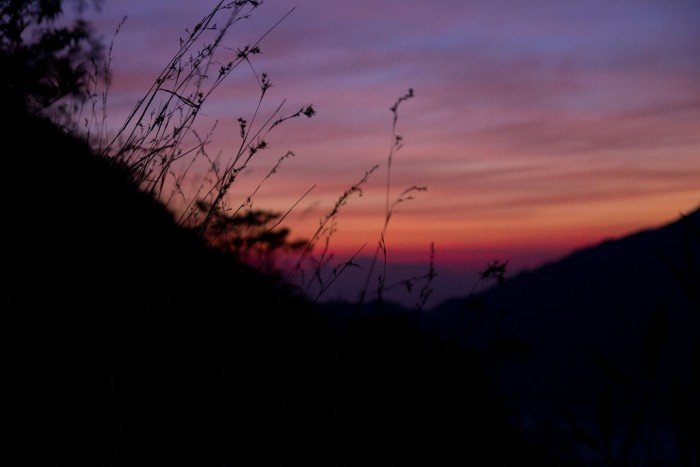Is It Safe to Travel to Bali with the Volcano Erupting?
Last updated on 29 December 2017.
In mid-September, Agung, Bali’s sacred volcano, which has effectively been sleeping for the last half century or so, woke up. On 22 September, authorities raised its status to the highest alert level, red (or level 4), and began evacuating tens of thousands of locals who lived within 7 to 12 kilometres of the volcano. A range of governments issued travel advisories advising caution and implying that it was not safe to travel to Bali. And everyone on Bali began the process of adapting to life with a volcano that’s a lot more active than we’d thought.
Over the succeeding two months, the mountain rumbled and juddered, emitting all sorts of sinister signals to the volcanologists monitoring it, yet, perhaps intimidated by the global attention, failed to erupt. Not long after the alert status returned to amber (level 3), when evacuees outside the 6-8km range had only just returned to their homes, Agung sprang into action on 21 November with a small eruption. On the evening of 25 November, a second, larger eruption ejected a significant ash cloud, causing some airlines, particularly JetStar, to cancel flights as a precaution. By the morning of 26 November the ash cloud reached at least 6,000 metres (Agung is over 3,000 metres high). On 27 November, the wind changed and the airport closed.
On 29 November, Bali airport reopened at 3pm, after the wind changed, despite a planned closure until 7am on 30 November. While the volcano alert status has returned to level 4 (danger), with evacuation zones in place at 8-10km from the volcano, the aviation code is now at orange, although for how long remains to be seen. Agung has been coughing quite a bit through December, but the wind direction has been favourable so this has not impacted either Bali or Lombok airports. Do note that Agung remains highly active and most consider it will do quite a lot more before it’s over: despite considerable pressure, the volcanologists consider it high risk.
As of 29 December, both Bali and Lombok airport were open for business, with domestic and international flights running pretty much as normal. The volcano remains at level 4, the highest available alert status, and the aviation code remains at level 3, amber: the government has invented a Bali status of level 2, but, as Rio Helmi explains, that’s meaningless PR nonsense. Australian tourist numbers seem to be close to normal, most mainland Chinese airlines have stopped flights until at least 31 January, and domestic visits are up.
If you have a flexible schedule, and are travelling on an Asian airline, now is a good time to visit Bali, with some excellent deals available. You should, however, plan for the possibility of travel disruption.
Do note that, as the gif below from Indonesia’s excellent Magma website shows, Agung is just one of many volcanoes across the archipelago: the nation’s volcanologists are really good at their jobs and provided you follow official guidance you should not be in danger. (You can take a look at the volcano from all sorts of places, just please don’t go into the evacuated zones.)

Does the eruption mean it’s no longer safe to travel to Bali? No. But you need to be aware of the possibility of airport closures, flight changes and travel delays. Agung is a famously unpredictable volcano and it could build to a large explosion over days, weeks, or months or, conceivably, go back to sleep without an explosion: it is impossible, even for volcanologists on the mountain with all available data at their fingertips, to predict what it is going to do. (Do check Stuart McDonald’s handy travel guide, volcanologist Janine Krippner’s advice and this great feed of all the volcano data you could want.)
Will Agung have a large eruption? Nobody knows. Expert opinion seems to be that it’s likely that the recent small ash eruptions will be followed by something larger and more explosive, which also matches anecdotal recollections of the last big eruption – but this is not a predictable volcano. Agung is one of only seven volcanoes in the world to have consistently hit 5 on the Volcanic Explosivity Index (the volcano Richter Scale), which is why experts remain concerned.
How long will this phase of activity go on for? Again, nobody knows. Agung’s last hissy fit, in 1963-1964, interspersed moments of drama with long periods of quiet, and included two very large explosive eruptions. At the moment, about all it’s fair to say is that it’s unlikely these ash clouds will be the last of it – although, of course, they could be. Agung has been setting personal bests on all forms of instrument readings since September, and my personal and entirely unscientific opinion is that it’s going to wait until everyone’s forgotten about it and then do something spectacular.
You may well have seen on social media, thanks to the “I am in Bali now” campaign, that there are tourists in Bali, who are perfectly safe and having a great time. With lower visitor numbers, there are some excellent deals on accommodation (Agoda has some great offers right now), and not only in areas like Ubud that are closer to Agung. You’ll also be helping the island’s economy and so, indirectly, the volcano refugees, so there is an awful lot to be said for visiting now.
If you’re wondering whether to travel to Bali, here’s what to consider:

1: Where Will You Be in Relation to the Volcano Danger Zones?
Above is a map showing Mount Agung and Bali’s best known tourist areas. Below is a map showing the areas of Bali that were considered unsafe in the event of an eruption like that of 1963 (the current evacuations reflect a slightly smaller area of concern, with a radius of 8-10km). The circles indicate the risk of falling particles of different sizes; the yellow flow patterns indicate the risk from mudflows known as lahars, while the pink flows represent lava and pyroclastic flows.

As you can see, essentially, unless you’re within 15km of the volcano, or in a valley that starts near the top of the volcano, it’s safe to travel to that bit of Bali. Ubud is 30km from Agung; Canggu is about 60km; Kuta is about 70km; the Bukit peninsula is even further.
Out of the typical tourist destinations, Tulamben, for diving, is unsafe: I would be cautious about visiting Amed for fear of road blockages, although with such great diving AND volcano views, it’s highly tempting. Sidemen and Candidasa are considered safe: Sidemen also offers incredible views if Agung’s next act is more photogenic than apocalyptic. If climbing Agung or diving Tulamben are must-dos for you in Bali, however, now is probably not the time to book a holiday, although many tourists are finding Agung makes an amazing selfie backdrop. (See this post for where to get the best views of the volcano.)
2: How Key Is It That You Get Back to Work on Time?
An Agung eruption does not necessarily mean airport closures: that’s dependent on whether Agung throws up ash, how much ash it throws up, how high that ash rises, and what direction the wind is blowing. (You can read my guide on what to do if a volcano cancels your flight here.) There have been ashclouds through most of December, in fact, but the wind is blowing away from the airport and, if the weather follows standard seasonal patterns, may continue to do so until march.
Generally speaking, if Denpasar airport is closed when you need to travel, you will be able to get in and out by travelling to Banyuwangi, Surabaya or Malang on Java, or Praya on Lombok, depending on which of those airports are still open, but that will take time to organise, while you can expect flight prices to soar. During the last closure, the airport arranged buses from domestic arrivals to Surabaya aiport for 300,000 IDR: the journey takes at least 12 hours, and I would allow 18. (Private cars typically cost around 2,500,000 IDR for a 7-seat Avanza.)
Do, however, note that the air traffic control and ground staff at Ngurah Rai played an absolute blinder during the recent closures and, let’s face it, there are worse places to be stuck than Bali!
So: if you’re a surgeon, a fertility doctor, a head teacher, self-employed in a sector where you need to be physically present to earn money or likely to be fired if you don’t come back to work on time, then I’d either not visit or plan travel to Bali through an airport that can be reached by various different connections, and leave at least a day in hand to reach that airport. If you’re in a normal job, let alone a job that allows you to work from home, then, hell, I’d take the risk.
3: Do You Have Serious Respiratory Problems?
IF Agung has a large eruption, and IF the winds are blowing the wrong way, volcanic ash COULD impact the tourist areas. It’s nasty stuff and, while both adults and children can protect themselves with N95-rated face masks, if you’re struggling with serious respiratory issues it makes sense to holiday somewhere that doesn’t have an erupting volcano.
4: Are You Travelling on a Shoestring?
World Nomads have been very upfront about this, but not all travel insurers have. Most travel insurers will not cover you for volcano-related cancellations or costs if you booked your holiday or bought your insurance between 20 September and 29 October or after 21 November, because the volcano was considered a known risk at those times – the equivalent of a pre-existing condition for medical insurance. However, World Nomads (and most other insurance) will still be usable for other non-volcano issues, such as medical expenses in the event of accidents, so don’t travel uninsured. (As always, do check the Ts & Cs before you buy.)
5: Will You Get Your Money Back?
Most airlines won’t refund flights unless they cancel them themselves or the airport closes – so, while JetStar did offer alternative destinations during the last bout of flight disruption, you’re unlikely to get your money back.
According to aviation guru Gerry Soejatman, Indonesian aviation law only covers domestic flights and specifically excludes volcanic ash and airport closures from its limited consumer protection so your airline will be within its rights to refuse you so much as a bottle of water.
If you’re planning long-haul travel now, consider routing through Jakarta: there is spare capacity to reach Jakarta from all of the nearby airports if Bali airport closes, and you may even get enough warning to hop on a domestic flight before it shuts. It makes for a longer journey but ensures you won’t miss expensive international connections.
As you can see, for most people, travel to Bali is safe – even with the eruption ongoing.
Here’s some suggestions for those planning Bali travel:

Fly with an Asian Airline
Australian carriers are notorious for cancelling flights when volcanoes go off around Bali, primarily because they don’t have the ground staff at nearby airports or even in Bali to handle stranded passengers and they don’t fly to enough Indonesian airports to be able to easily reroute the plane. Despite its PR nonsense about “rescue flights” and “safety”, JetStar has not done well by its stranded passengers to date, and its motivations are economic.
Leave Time Around Connecting Flights
If you’re flying to Europe or the US through regional hubs like Kuala Lumpur or Singapore, allow yourself at least a day’s layover for your return flight. That means that IF the airport is closed the day you’re due to fly out, you can hop on a boat to Lombok, arrange a brutal bus ride or expensive car trip to Surabaya, or head to Banyuwangi to fly to Jakarta, and still make your connecting flight. Also consider booking important connections out of Jakarta, if that’s practicable: it widens your choices of non-Bali airports in the event of crisis. Do note that you can follow the projected path of any ash cloud using graphic projections from Darwin VAAC’s volcanic ash advisory. So, for example, if your flight home is from Jakarta in two days’ time and an ash cloud starts moving towards Bali airport, you might want to pick up a domestic flight immediately: there are loads.
Bring N-95 Masks
Will there be ashfall of a level that could endanger health where you are in Bali while you’re there? Probably not. But it’s worth being prepared with N-95 masks just in case. When you’re leaving, donate them to the evacuees, who really need them: pay a Gojek motorbike taxi to deliver them to Solemen Indonesia’s dropoff centres.
And, whew! I think that’s it! If you’ve got any questions I haven’t answered here, feel free to post them in the comments: if I can’t answer them myself, I’ll probably know someone who can.

Although they’re of different type of volcano, I can’t help but think of what happened to Krakatau after constantly monitoring Agung’s development. For weeks nothing happened to Krakatau except an increase in volcanic activity. Then, boom! As you said, volcanoes are unpredictable beasts, but worrying too much wouldn’t get you anywhere — literally and figuratively.
Thank you for sharing the information about the volcano. Bali is undoubtedly on everyone’s bucket list and this informative blog will really help the traveller.
Really a good and complete full of information and motivation !
This is an excellent article, thank the president.
Typo above – that shouldn’t say thank president it should say thank you! That might just be the craziest thing my predictive text has ever done.
It did make me wonder! I was like – what on earth does Trump have to do with Gunung Agung?! But thanks for your kind words….